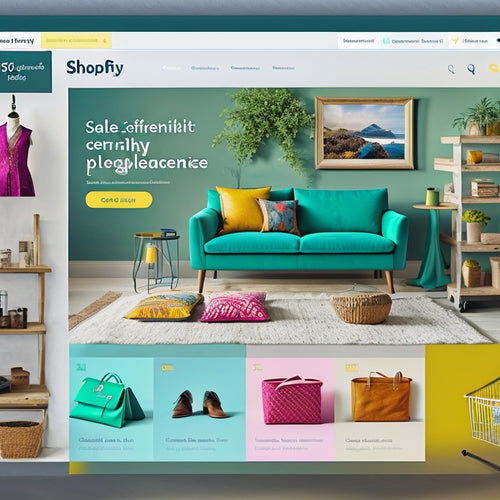
Elevate Your Ecommerce With Top Online Training Resources
Share
You can elevate your ecommerce business by leveraging top online training resources that focus on strategic course creation, personalized learning paths, and interactive engagement tools. To create high-quality courses, you'll need to understand your target audience, structure content logically, and incorporate storytelling methods and interactive elements. Developing interactive quizzes, designing visually appealing slides, and creating downloadable resources can also enhance the learning experience. By analyzing key performance indicators and refining strategies based on data, you can optimize the impact of your training programs and drive business growth. Now, explore the essential skills and strategies to take your ecommerce training to the next level.
Key Takeaways
• Effective online courses require engaging storytelling, interactive elements, and logical instructional design to boost ecommerce skills.
• Personalized learning paths with gamification, microlearning, and real-world examples increase learner engagement and motivation.
• Interactive quizzes with customized feedback and assessment strategies evaluate learner knowledge and identify skill gaps.
• Visually appealing slide design with clear typography, balanced layouts, and high-quality visuals enhances the learning experience.
• Measuring course success with key metrics like completion rates, time-to-competency, and ROI helps optimize ecommerce training programs.
Mastering Online Course Creation
To successfully navigate the online learning landscape, you need to master the art of creating engaging, informative, and well-structured online courses that cater to diverse learning styles and preferences. By doing so, you'll be able to capture and retain students' attention, driving meaningful student engagement and ultimately, course success.
Effective course marketing is essential to attracting the right audience and setting your course up for success. You must develop a clear understanding of your target audience, craft compelling course descriptions, and create eye-catching visuals that resonate with your learners.
Additionally, instructional design plays a crucial role in course creation, as it enables you to structure your content in a logical and easy-to-follow manner. By incorporating multimedia elements, such as videos, quizzes, and interactive simulations, you can create an immersive learning experience that fosters active learning and boosts knowledge retention.
Ultimately, mastering online course creation is key to driving course monetization. By creating high-quality, engaging courses that meet the needs of your learners, you'll be able to build a loyal student base, generate recurring revenue, and establish yourself as a thought leader in your industry.
Building Effective Learning Paths
Building Effective Learning Paths
By structuring your online course content into a logical and progressive learning path, you'll guide students through a seamless and efficient learning experience that builds upon prior knowledge and skills. This strategic approach enables you to tailor your content to meet the diverse needs of your learners, ensuring they stay engaged and motivated throughout the course.
To create effective learning paths, consider the following strategies:
| Strategy | Description |
|---|---|
| Personalized learning plans | Tailor course content to individual learners' needs, goals, and learning styles |
| Gamification strategies | Incorporate game-like elements, such as rewards and challenges, to increase engagement and motivation |
| Microlearning modules | Break down complex topics into bite-sized, easily digestible chunks |
| Real-world examples | Use relatable, real-world scenarios to illustrate key concepts and principles |
| Assessments and feedback | Regularly evaluate student progress, providing constructive feedback to guide improvement |
Crafting Engaging Video Content
By incorporating storytelling methods, visual hints, and interactive elements into your video content, you can engage your learners' attention, foster emotional connections, and convey complex information in an easily understandable format.
To elevate your video content, master video editing techniques that enhance the narrative flow and visuals. Engaging storytelling is essential, so focus on crafting a compelling script that resonates with your audience. Consistency in visual branding is also vital, ensuring that your brand's identity shines through in every frame.
To boost audience engagement, incorporate interactive elements such as animations, shifts, and captions. These visual hints will help learners absorb information more effectively and stay engaged throughout the video.
Developing Interactive Quizzes
You can further amplify learner engagement and retention by incorporating interactive quizzes that test their understanding and encourage active participation. This approach not only assesses knowledge but also fosters a deeper understanding of the material. To take your quizzes to the next level, consider the following strategies:
| Quiz Feature | Benefits | Best Practices |
|---|---|---|
| Quiz customization | Personalize the learning experience, increase engagement | Use learner data to tailor quiz questions and feedback |
| Interactive feedback | Provide immediate feedback, encourage reflection | Use gamification techniques, such as points or badges, to motivate learners |
| Assessment strategies | Evaluate learner knowledge, identify knowledge gaps | Use a mix of question types, including multiple-choice and open-ended, to assess comprehension |
Designing Visually Appealing Slides
Crafting visually appealing slides is vital to capturing learners' attention, as it can greatly enhance their overall learning experience and drive home key concepts more effectively. You want to create slides that engage, inform, and inspire.
To do this, you'll need to master the art of visual design. Start by understanding color theory, selecting a palette that resonates with your brand and audience. Then, choose slide layouts that balance text, images, and white space. Typography is also essential – pick fonts that are clear, readable, and consistent.
When it comes to image selection, opt for high-quality visuals that support your message, rather than distracting from it. Remember, the goal is to communicate complex ideas simply and elegantly.
Creating Downloadable Resources
To take your online training to the next level, create downloadable resources that learners can use as reference materials, reinforcing their understanding of key concepts and facilitating continued learning beyond the virtual classroom. These resources can include e-books, whitepapers, worksheets, or templates that learners can access at their convenience.
By providing organized and structured content, you'll improve user engagement and encourage learners to revisit and apply the knowledge they've acquired.
Strategically, downloadable resources can also serve as a marketing tool, generating revenue through lead magnets or gated content. By offering valuable resources in exchange for contact information, you can build your email list and nurture leads through targeted marketing campaigns.
Additionally, downloadable resources can be used to upsell or cross-sell relevant products or services, increasing revenue generation. To maximize the impact of your downloadable resources, make sure they're well-designed, informative, and easy to access.
Producing High-Quality Audio
High-quality audio production is crucial for engaging learners and effectively conveying intricate information, as it can greatly enhance the overall learning experience and reinforce key concepts.
You want to make certain that your audio is sharp, distinct, and free from disturbances. To accomplish this, you'll need to invest time in sound production and audio editing.
Here are some tips to help you create high-quality audio:
- Invest in excellent recording equipment, such as a microphone and headphones, to capture clear and sharp sound.
- Select a quiet recording space with minimal background noise to prevent interruptions.
- Utilize audio editing software to enhance your recordings, eliminating any unwanted sounds or breaks.
- Focus on sound levels, making sure that your audio is well-balanced and easy to listen to.
Building a Learner Community
You'll need to nurture a sense of community among your learners to maximize engagement, motivation, and knowledge retention, as a unified group dynamic can greatly enhance the learning experience.
This is essential in ecommerce training, where learners may be spread out across different locations and time zones. To build a strong learner community, you should encourage learner feedback through regular surveys, discussion forums, and live sessions.
This will help you understand their needs, concerns, and progress, allowing you to tailor your training content and approach accordingly. Additionally, community engagement is crucial to keeping learners motivated and accountable.
You can achieve this by creating a shared goal or challenge that learners can work towards together, or by recognizing and rewarding outstanding achievements. By doing so, you'll create a collaborative environment where learners can learn from each other, share best practices, and support one another in their ecommerce journey.
Measuring Course Success Metrics
By analyzing key performance indicators, you're able to gauge the effectiveness of your ecommerce training program and make data-driven decisions to optimize its impact. Tracking progress and analyzing data helps you identify areas of improvement, refine your strategy, and allocate resources more efficiently.
To measure course success, focus on the following key metrics:
-
Completion rates: Monitor the number of learners who complete each module or course to identify engagement levels and potential roadblocks.
-
Time-to-competency: Track how long it takes learners to achieve specific skills or knowledge to refine your training content and delivery.
-
Knowledge retention: Assess learners' ability to apply what they've learned over time to improve retention and reduce the need for retraining.
- Return on investment (ROI): Calculate the financial impact of your training program to justify investment and make informed decisions about future initiatives.
Frequently Asked Questions
How Do I Choose the Right Ecommerce Platform for My Online Course?
When selecting an ecommerce platform for your online course, you'll want to compare platforms, weighing features like user experience, payment options, and scalability, to guarantee seamless transactions and a hassle-free learning environment for your students.
Can I Sell My Online Course on Multiple Platforms at Once?
Imagine being a skilled juggler, expertly juggling multiple balls (platforms) at once. You can definitely sell your online course on multiple platforms simultaneously, diversifying your marketing strategies and revenue streams, but be prepared to manage each platform's unique demands.
How Much Does It Cost to Host an Online Course?
You'll pay between $39 and $499 per month to host your online course, depending on the platform and features. Consider pricing strategies, competition analysis, and marketing tactics to maximize revenue potential and stay ahead of the game.
Do I Need to Be an Expert to Create an Online Course?
"You don't need to be a Nobel laureate to create an online course - not even close! With beginner-friendly course creation tools and a willingness to share your skills, you can teach others regardless of your skill level."
How Do I Protect My Online Course Content From Being Stolen?
To safeguard your online course content, you'll want to implement content encryption and copyright protection measures, as well as digital rights management and secure delivery systems to prevent theft and unauthorized access.
Related Posts
-

10 Best Online Courses for Merchants to Scale
You're scaling your online store, and you know it's not easy. From ecommerce fundamentals to product visibility and i...
-
Quick Comparisons of the Best Shopify Sitemap Apps
This article provides a comprehensive analysis of the top Shopify sitemap apps available in the market. The objectiv...
-

Which Sales Channel Is Best for Shopify
This article aims to provide an objective analysis of the various sales channels available for Shopify. It explores ...

